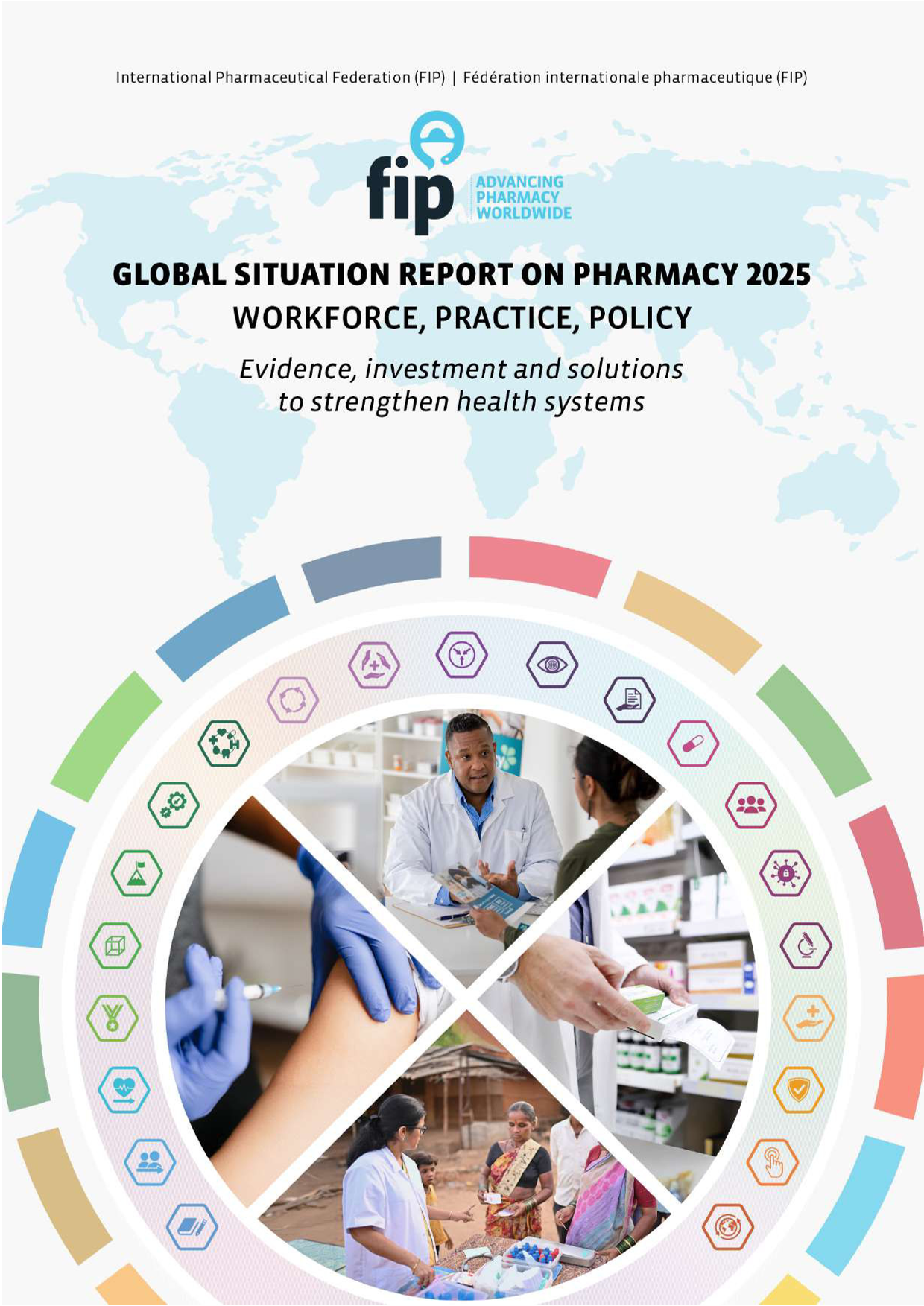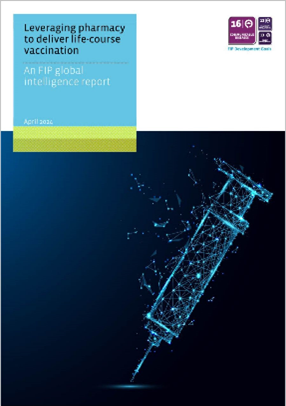The MNAP projects aim to establish and monitor the needs of nations and members and also feed into regional and global needs assessments. All MNAP projects are evidence-led based on needs and focus on different pharmacy areas, including science, practice, workforce and education/CPD. MNAP ensures a consistent methodological approach to assessing needs and evaluating trends by identifying the necessity for FIP-enabled transformation programs and involving various FIP constituencies. MNAP serves as both a member benefit and a recruitment tool for non-members, aligning with FIP Development Goals (DGs). MNAP provides a systematic vehicle for GPO data collection for the decade ahead and supports disseminating results through reports, peer-reviewed publications, and membership bulletins.
The Multinational Needs Assessment Projects include the following:
- Pharmacy in Sub-Saharan Africa: A FIP Situational Report
- Multinational Education Training Needs Assessment (METNA)
- Pharmacists’ role in diphtheria-tetanus-pertussis booster, COVID-19 and meningitis vaccinations
- The role of pharmacists in iron deficiency anaemia
- How can digital health support national pharmaceutical care delivery? A regional and global assessment of priorities and challenges
- What community pharmacy teams need to support good hygiene as part of people’s self-care
- Community pharmacy team’s understanding of self-care
The surveillance projects focus on the systematic collection, analysis and interpretation of pharmacy-related data. This is important for the monitoring and understanding of the evolving trends and advancements in key areas of practice, education, and workforce. Through surveillance, FIP offers its members access to valuable data visualisations and interactive tools facilitated by the FIP Atlas, impact database, and development goals indicators.
- Global Workforce Surveillance Project
- Vaccination Surveillance Project
- FIP Development Goals Indicators Surveillance Project
- Impact Database
The Multinational Needs Assessment Projects include the following:

1 – Global Situation Report on Pharmacy 2025
Drawing on global data, FIP data gathering, contributions from FIP member organisations, and real-world case studies from across the six World Health Organization (WHO) regions, the report serves as a strategic blueprint, outlining clear priorities and actions to advance pharmacy practice, education, science, and workforce development in alignment with the WHO Global Workforce Strategy 2030. It supports the United Nations Sustainable Development Goals, particularly those related to health, equality and sustainability, and is driven by the FIP Global Development Goals. Furthermore, the report supports the organisation’s broader strategic plan for 2025–2030 and the WHO–FIP Collaboration Workplan (2024–2025)
Aligned with global health priorities, this report presents insights on:
- Workforce capacity and distribution;
- Pharmacy education and specialisation pathways;
- Evolving scope of pharmacy services;
- Digital health transformation and innovation; and
- Migration, equity, and professional resilience.
More key findings can be explored below:
- Access report here

2 – Pharmacy in Sub-Saharan Africa: A FIP Situational Report
Against the backdrop of a region with the world’s highest disease burden and lowest density of healthcare workers, the report presents 12 case studies contributed by FIP member organisations in Cameroon, DR Congo, Ghana, Liberia, Malawi, Nigeria, Rwanda, South Africa, Sierra Leone, Tanzania, Uganda and Zimbabwe.
The report outlines important insights into pharmacy workforce development and shortages, pharmacy’s roles in managing and preventing communicable and non-communicable diseases, pharmacists’ contributions to humanitarian efforts, and environmental sustainability in pharmacy practice.
Two main key findings include the following:
- Pharmacists are essential in improving healthcare outcomes in Sub-Saharan Africa, especially in managing both communicable and non-communicable diseases.
- Strategic investments in pharmacy education and the development of supportive policies are vital to expanding pharmacists’ roles and improving healthcare delivery.
More key findings can be explored below:

3 – Multinational Education Training Needs Assessment (METNA)
The FIP’s Multinational Education and Training Needs Assessment project, engaging 26 national professional organisations from 21 countries, revealed varied education, training, and workforce development systems and priorities aligned with FIP Development Goals.
This evidence-based study identified pharmaceutical development priorities and mapped out the challenges, priorities, and national programmes in pharmacy workforce education and training.
The project aimed to assess the pharmacy workforce’s current capacity, identify capacity-building challenges, and pinpoint ongoing national initiatives and needs.
The figure below provides a summary of the data collection process.

4- Pharmacists’ role in diphtheria-tetanus-pertussis booster, COVID-19 and meningitis vaccinations
The aim of this project was to identify the current role of the pharmacist in DTP booster, COVID-19 and meningococcal meningitis vaccination, and to establish factors, gaps and needs for expanding that role in countries that already have regulated pharmacy-based vaccination services.
We conducted a desktop review to identify countries with existing pharmacy-based vaccination services, followed by an online questionnaire distributed to those countries.
Two main key findings include the following:
- The expanded role of pharmacists and pharmacies in vaccination services has been achieved through legislative, regulatory and advocacy efforts. The education and training of pharmacists in immunisation were also often undertaken prior to a change in policy to demonstrate that pharmacists were ready to advocate the expansion of their role and thereby support increasing vaccination rates in their countries.
- To leverage pharmacists’ role in vaccination and pharmacy-based vaccination services, support related to (i) development of regulation and policy on vaccination authority, (ii) stakeholder engagement, acceptance and recognition of pharmacists’ role, (iii) logistics for pharmacy-based vaccination services, and (iv) education and training were highlighted.
More key findings can be explored below:

5- The role of pharmacists in iron deficiency anaemia
This handbook provides pharmacists with the latest insights into iron deficiency anaemia, drawing on collective evidence and recommendations from existing guidelines and expert consensus. It addresses not only pharmacological treatment and non-pharmacological interventions but also prevention strategies. Additionally, the handbook covers guidelines for managing IDA in special populations, including paediatrics, non-pregnant women of reproductive age, pregnant women and breastfeeding mothers, the elderly, patients with chronic diseases, and individuals on strict diets.
Overall, this handbook serves as an invaluable resource for pharmacists in managing IDA, underpinning the importance of pharmacists’ role in screening, managing, treating, patient education, and holistic self-care practices.

6- How can digital health support national pharmaceutical care delivery? A regional and global assessment of priorities and challenges
Among the objectives of this project was an imperative to discuss the challenges and opportunities that nations and professional leadership bodies face in implementing digital health in pharmaceutical care services, in addition to highlighting initiatives that are currently being undertaken globally.
This project comprised a series of six regional events conducted to discuss the needs and challenges that nations and professional leadership bodies face in using digital health to support medicationadherence and combat SF medicines.

To conclude this project, in November 2022, a roundtable meeting was hosted with pharmacy leaders from the six WHO regions and experts in the field of digital health. The roundtable aimed to assess and discuss selected best practices and ongoing initiatives; barriers, challenges, and recommendations in the implementation of digital health in pharmaceutical care services; education and training needs; and future areas of work and opportunities for growth.
The digital recordings of the regional needs assessment events are available here The report, which is accessible to FIP members only can be found here.

7 – What community pharmacy teams need to support good hygiene as part of people’s self-care
Self-care is often thought of as what people do for themselves to establish and maintain health and to prevent and deal with illness. This project aimed to describe community pharmacy insights into hygiene and pharmacy teams’ role in addressing germ concerns of the public.
FIP GPO conducted a literature review to identify the pharmacy team’s drivers, knowledge gaps and learning needs in this area, followed by an online questionnaire disseminated to five FIP member organisations (MOs) – India, Indonesia, Saudi Arabia, South Africa and Thailand.
Two main key findings include the following:
- There was an unequivocal need to support, train and educate community pharmacists and their teams to improve their knowledge because the concept of increasing personal hygiene awareness is a focus area of community pharmacists in developed and developing countries.
- Community pharmacists and their teams can play a leading role in providing reliable recommendations and educating patients on health hygiene, engaging and empowering patients in self-care, and minimising the spread of contagious diseases, ultimately contributing to improving our communities’ overall health.
Full access to the report is here

8 – Community pharmacy team’s understanding of self-care

The aim of this project was to investigate the community pharmacy team’s involvement in self-care support, including their understanding of self-care, their learning needs, their engagement, barriers and enablers in supporting people’s self-care from a global perspective.
Two main key findings include the following:
- The published report highlights that community pharmacists recognise the importance of offering various self-care support activities. This acknowledgment presents a unique opportunity for the pharmacy profession to develop a cohesive strategy to address existing learning gaps and barriers. By doing so, community pharmacists can play a more significant role in promoting public health and empowering individuals to manage their well-being, ultimately improving healthcare access and quality of life.
- The report also identifies key themes that could improve community pharmacy practice and overall management for better self-care support delivery, including better use of digital self-care tools and healthcare technologies.
Full access to the report is here
The link to the digital event is here
9 – Data and Intelligence Digital Events Programme
Digital events will focus on supporting FIP member organisations in developing their pharmacy intelligence infrastructure and link to the work underway on the development goal indicators to support tracking progress against priority development goals. There will also be events that will highlight innovative areas such as artificial intelligence and the interfaces with digital health. Potential topics will include how to use data and intelligence to provide evidence and impact and:
- Improve effectiveness of services;
- Promote patient safety;
- Ensure effectiveness of treatments, devices and tech;
- Support new models of care;
- Enhance decision making;
- Contribute to policy development;
- Support population health;
- Help make best use of healthcare resources.
All FIP and GPO events and webinars are available by accessing the FIP Events and webinars.
The surveillance projects focus on the systematic collection, analysis and interpretation of pharmacy-related data. This is important for the monitoring and understanding of the evolving trends and advancements in key areas of practice, education, and workforce. Through surveillance, FIP offers its members access to valuable data visualisations and interactive tools facilitated by the FIP Atlas, impact database, and development goals indicators.
1 – Global Workforce Surveillance Project

Global pharmaceutical workforce data has been collated by FIP since 2006. Analysis of data from 2009 and 2017 has enabled trends to be monitored over this period; the results have been published in sequential FIP Global Pharmacy Workforce Intelligence Trends Reports and peer reviewed literature, marking FIP as the single major global holder of this data. The findings have subsequently enabled Member Organisations (MOs) to monitor national, regional and global workforce capacity changes and trends, informing their workforce planning and leadership strategies.
This project aims to update data on global pharmacy workforce intelligence in order to further monitor the trend of the pharmacy workforce from 2006 to 2022. We are seeking to work more closely with MOs in order to achieve this aim. There can be no health workforce planning without workforce intelligence and the importance of national workforce intelligence and monitoring systems has been expressed by our MOs during our previous engagement meetings.
We keep our data collection open, and if there are any member organisations who would like to contribute, please approach us in observatory@fip.org
To view the ATLAS of the global pharmacy workforce, click the link here.
2 – Vaccination Surveillance Project
The vaccination surveillance project aims to develop an interactive, useful, and comprehensive FIP global database on the role of pharmacists in vaccination to support the advocacy work of FIP and its member organisations. As part of this project, we reviewed our existing data and conducted online questionnaires among our members to update our database.

1 – Funding models, and economic and societal impact of pharmacy-based vaccination: Findings from FIP reports and literature
This report draws on data from the 2024 FIP global vaccination surveillance survey, literature reviews, and international case studies. The report presents broader societal value of vaccination, explores the different health system types and examines trends of the four main PBV funding models adopted across countries: public reimbursement, private insurance, out-of-pocket payments, and pharmacy-funded services.
The report also identifies barriers to sustainable implementation of PBV and provides an overview of procurement strategies essential to ensuring timely and equitable vaccine supply. It also highlights the economic impact of PBV, drawing on global evidence to demonstrate its cost-effectiveness and return on investment.
Finally, the report presents a selection of country case studies from FIP member organisations to showcase diverse national approaches to PBV through legislative frameworks, funding models, economic and public health impacts, and lesson learned from implementation.
Full access to the report is here
Access the executive summary here Access infographic to the report here

2 – Policy progress, stakeholder engagement and challenges in pharmacist-led vaccination: Findings from FIP reports and literature
This report provides an evidence-based foundation for understanding the global progress and disparities in pharmacy-based vaccination (PBV) policies and practices. Through the analysis of legislative frameworks, stakeholder roles, and implementation strategies, the report aims to offer actionable insights that support the advancement of PBV globally. The insights drawn from this report may be particularly useful for countries with similar contexts, enabling them to learn from successful strategies and avoid common pitfalls.
Through the findings, the report will address legislative gaps, promote evidence-based advocacy as well as evidence-based decision-making, and strengthen the role of pharmacists in achieving equitable and comprehensive immunisation coverage globally.
Full access to the report is here
Access infographic to the report here

3 – Leveraging pharmacy to deliver life-course vaccination: An FIP intelligence report
This report presents quantitative data and insights on the global state of pharmacy-based vaccination, providing evidence to support advocacy for an expanded role of pharmacists in increasing vaccination coverage. It highlights recent advancements in this critical area of pharmacy practice and offers a preliminary overview of remuneration data, which will serve as the foundation for a more detailed analysis to be released in a follow-up report.
Full access to the report is here
Access the executive summary here

4 – Pharmacy-based vaccination: Recent developments, success stories and implementation challenges
This report presents 17 case studies and country updates from FIP member organisations, highlighting recent developments, achievements, and challenges in pharmacy-based vaccination—particularly in countries that have recently adopted or expanded PBV services.
The report also aims to uphold FIP’s global and regional advocacy of vaccination-related roles by pharmacists, and to provide FIP member organisations with examples that can support their own process and advocacy. Full access to the report is here



